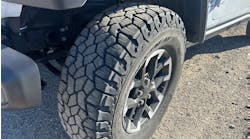Do you know the main difference between bias ply and radial ply tires for earthmoving machines?
See if you can answer the following questions, based on information supplied by Michelin.
1. What is the design of a conventional bias ply earthmover tire?
2. What is the design of a radial earthmover tire?
3. What is the impact of tire-ground contact on a conventional bias earthmover tire?
4. What is the impact of tire-ground contact on a radial earthmover tire?
The answers
1. The tire is composed of several angled fabric ply layers that all overlap. This is known as bias construction.
2. The crown is stabilized by a steel belt layer, comprised of several ply layers. The tire is made from one, single radial layer of steel cables. Sidewalls and tread bands work independently.
3. Severe tire deformation and excess wear on all parts of the tire. During usage, all bending is transmitted to the tread band due to overlapped angled plies. Surface deformation due to ground contact results in excess heat, ground friction and greater motion resistance.
4. The sidewalls and tread band work independently. The tread band is not affected by the bending sidewalls. Surface deformation reduction despite ground contact means less ground friction, minimal heat and minimal motion resistance.
So? How did you do?




